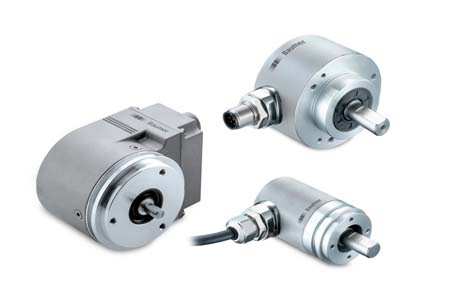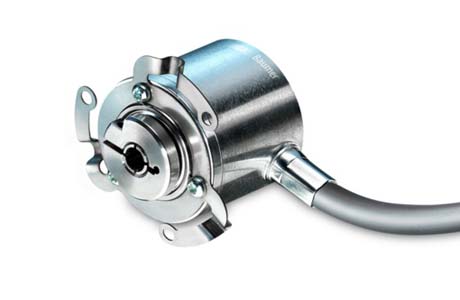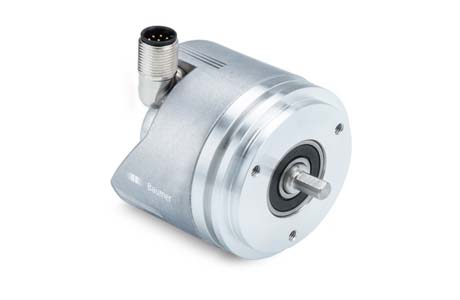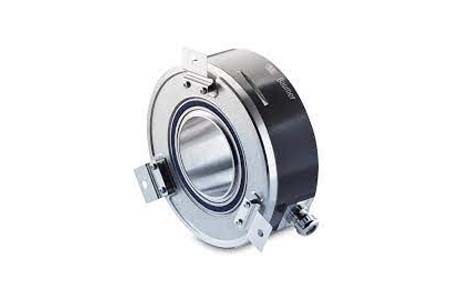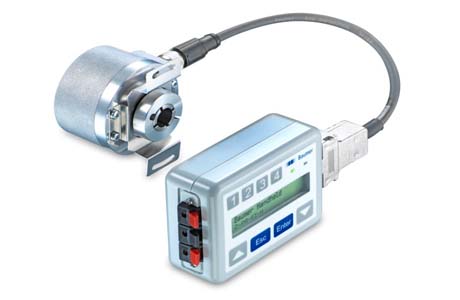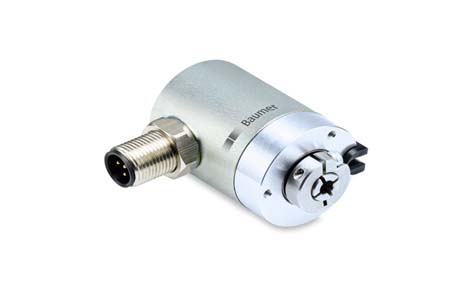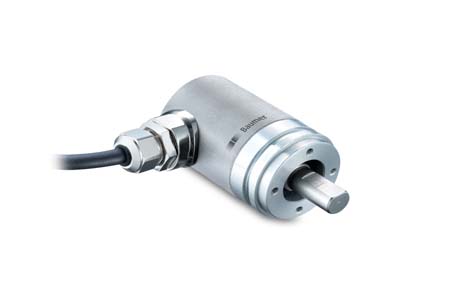Baumer Encoder: Incremental and Absolute Encoder
At IndMALL Automation, we’ve got a great selection of Baumer Encoder. These are top-notch tools for industrial engineers.
You’ll find small ones at 24 mm and bigger ones at 85 mm. They fit different shafts, both solid and hollow, and can handle up to 80,000 pulses per revolution.
Whether you need incremental or absolute types, we’ve got them with outputs like TTL, HTL, and SinCos. They’re easy to install and work with a variety of shaft sizes. Plus, you can program them for your specific needs. Check out our Baumer Encoders to find the right fit for your projects.
Baumer Encoder: Design 24 mm
- Size (Flange): ø24 mm
- Shaft Types: ø4 mm blind hollow shaft, ø4 mm solid shaft
- Pulses/Waves per Revolution: Range from 30 to 1024
- Output Stages: TTL, Push-pull short-circuit proof
Baumer Incremental Encoder: Design 58 mm
- Resolution: Up to 4096 pulses per revolution.
- Shaft Options: Solid shaft and through hollow shaft available.
- Output Types: TTL, HTL, SinCos for versatile interfacing.
- Connection Flexibility: Multiple connector options including M12 and M23.
- Design: Engineered for high flexibility in industrial connections.
Encoder Baumer: ø85 mm
- Resolution: Up to 80,000 pulses per revolution (PPR).
- Sensing Technology: High-precision optical sensing.
- Design: Shallow installation depth, suitable for direct installation on drive shafts.
- Shaft Diameter: Accommodates large hollow shafts up to 85 mm.
Baumer Rotary Encoder
- Resolution: Programmable from 1 to 65,536 ppr.
- Design: Available in 58 mm designs, accommodating up to 1 inch hollow shaft.
- Signal Output: Options include HTL and TTL.
- Programmability: Pulse sequence and zero pulse can be programmed.
Baumer Incremental Encoders
- Resolution: Up to 5000 sine periods per revolution.
- Output: SinCos 1 Vpp.
- Shaft Options: Includes through hollow and solid shafts.
- Design: ø58 mm flange, optimized for industrial use.
- Technology: Incorporates patented LowHarmonics for superior signal quality.
Baumer Absolute Encoder: 30mm
- Resolution: Up to 16384 steps per revolution, 262144 revolutions.
- Shaft Options: Solid shaft (5 to 8 mm) and blind hollow shaft.
- Interfaces: SSI, CANopen, CANopen Lift.
- Accuracy: Angular accuracy up to ±0.15˚.
- Design: Compact, smallest multiturn encoder with radial or axial connections.
Baumer Magnetic Encoder: 36mm
- Shaft Options: Solid shaft, blind hollow shaft, or bearingless kit.
- Interfaces: SSI, CANopen, CANopen Lift.
- Features: Additional incremental signals.
- Shaft Diameter: Up to 15 mm.
- Accuracy: Angular accuracy up to ±0.15˚.
IndMALL offers a selection of Baumer encoder, renowned for precision and reliability in industrial applications. Our range includes Baumer incremental and absolute encoders, available in both solid and hollow shaft designs.
These encoders excel in monitoring rotational speeds and positions. The Baumer rotary and magnetic encoders are particularly suited for challenging environments like wind turbines and machine installations.
At IndMALL, we provide a comprehensive portfolio of Baumer encoders, ensuring the right fit for various industrial needs. Our dedicated service team is ready to assist with tailored solutions, enhancing signal and control quality in your operations.
Product List:
Model No |
Image |
Size |
Sensing method |
Output signals |
Shaft type |
Pulses per revolution |
|---|---|---|---|---|---|---|
| EIL580-B | 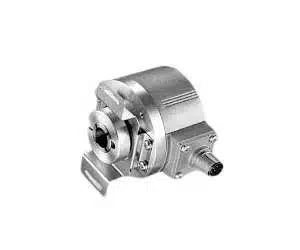 |
ø58 mm | Optical | A+, B+, R+, A-, B-, R | blind hollow shaft | 100…5000 |
| EIL580P-SY | 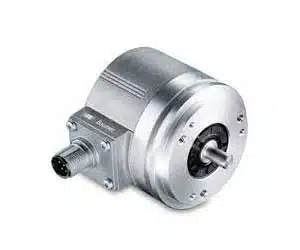 |
ø58 mm | Optical | A+, B+, R+, A-, B-, R- | solid shaft with flat | 1 … 65536 |
| EIL580P-T | 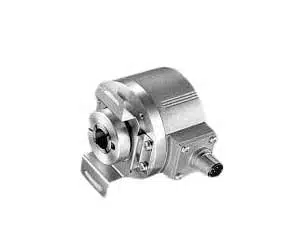 |
ø58 mm | Optical | A+, B+, R+, A-, B-, R- | through hollow shaft | 1 … 65536 |
| EIL580-SC | 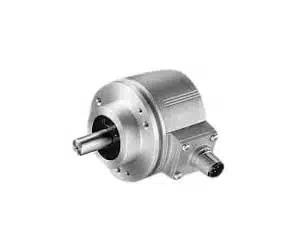 |
ø58 mm | Optical | A+, B+, R+, A-, B-, R | solid shaft with flat | 100…5000 |
| ITD-01-A-4-Y-1 | 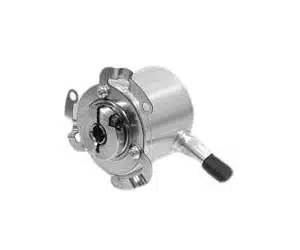 |
ø24 mm | Optical | A 90° B, N | blind hollow shaft | 30 … 1024 |
Our selection of Banner Encoders is designed to meet a variety of power needs and uses. Here are some of models:
- The EIL580-B model features a ø58 mm size with optical sensing and outputs A+, B+, R+, A-, B-, R-. It’s designed with a blind hollow shaft and offers 100 to 5000 pulses per revolution.
- The EIL580P-SY, also ø58 mm, uses optical sensing and similar output signals but comes with a solid shaft with a flat surface, supporting 1 to 65536 pulses per revolution.
- For those needing a through hollow shaft, the EIL580P-T provides the same size and sensing method, with a pulse range of 1 to 65536.
- The EIL580-SC model mirrors the EIL580-B in size and sense but has a solid shaft with a flat surface and offers 100 to 5000 pulses per revolution.
- Finally, the ITD-01-A-4-Y-1 is a smaller ø24 mm option, featuring optical sensing with A 90° B, N output signals, a blind hollow shaft, and a pulse range of 30 to 1024.
Frequently Asked Questions
How does incremental encoder work?
An incremental encoder is a device that tracks motion. It turns movement into signals. When something moves, the encoder sends out pulses. These pulses count how much movement happens.
The encoder has a disk with lines on it. This disk spins when something moves. Each line on the disk creates a pulse. More lines mean more pulses for better accuracy.
The pulses go to a machine or computer. This machine reads the pulses to understand the movement. It knows how far, how fast, and in which direction something moved.
Incremental encoders are used in machines and robots. They help these machines move correctly and precisely.
Are encoders AC or DC?
Encoders can work with both AC and DC power. It depends on their design and what they’re used for. AC stands for alternating current, and DC stands for direct current.
Most encoders in industrial machines use DC power. DC power is stable and works well for precise tasks. It’s like the power from a battery.
Some encoders can use AC power too. AC power is like what you get from home outlets. These encoders are less common but still useful in certain situations.
So, encoders can work with both types of power. It just depends on their specific design and purpose.
What is the output signal of a rotary encoder?
A rotary encoder creates signals to show how something is moving. These signals tell us the position and speed of the movement.
There are two main types of signals: digital and analog. Digital signals are like on-off switches. They are clear and precise. Analog signals vary in strength and are less common in rotary encoders.
Most rotary encoders use digital signals. These signals are easy to read by computers and machines. They help in controlling how machines move and work.
So, the output signal of a rotary encoder is usually a series of digital pulses. These pulses give accurate information about movement.
How do rotary encoders measure distance?
Rotary encoders measure distance by counting turns. They are attached to a rotating part, like a wheel or shaft.
As the part turns, the encoder counts each rotation. It does this using special sensors inside. These sensors detect marks or lines on a disk that spins with the part.
Each mark or line equals a certain distance. The encoder adds up these distances as it counts. This way, it knows how far the part has turned.
By counting rotations and knowing each turn’s distance, the encoder calculates the total distance. This helps machines and devices move accurately and know their position.
To inquire about the Baumer Encoder, For more information contact us.

